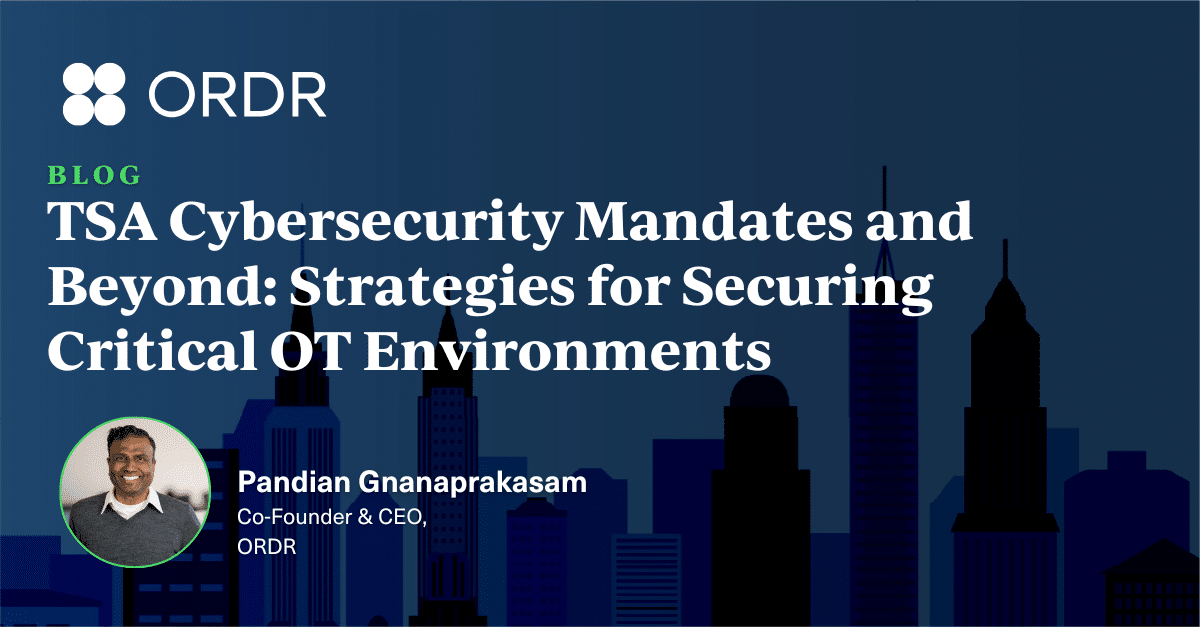Great news! Ordr just announced the availability of the Service Graph Connector for Ordr in the ServiceNow Store. This integration is exciting for our customers, who can now maintain an up-to-date system of record for all assets so organizations can operate efficiently, react quickly, and manage risks more effectively.
Service Graph Connector for Ordr now available in the ServiceNow Store
Ordr provides the most comprehensive, accurate, real-time inventory of connected assets as a single source of truth. As the threat surface continuously evolves and expands, it is critical to ensure asset inventories are complete and provide the context to address risk proactively and reactively. With ServiceNow and Ordr’s bidirectional integration, Ordr’s device, network, and risk context are combined with the business context of ServiceNow. And the new Service Graph Connector for Ordr makes the integration more manageable and robust.
You now get a robust, most comprehensive, accurate real-time inventory of connected assets—from traditional IT to IoT, IoMT, and OT — and their risks in the ServiceNow Configuration Management Database (CMDB) to optimize enterprise-wide workflows and assess and manage risks.
Top Ten Security Risks of Incomplete and Outdated Asset Inventories
As given below, there are significant entry points that cybercriminals can exploit. With the combination of Ordr and ServiceNow, security and IT teams can identify and mitigate the following asset risks.
- Banned Equipment (Section 889)
To protect national security, the federal government bans products manufactured by prohibited companies such as Kaspersky, Huawei, and Hikvision. These banned products can have vulnerabilities if exploited, resulting in the loss of intellectual property. The mandate covers new procurement and requires reporting within one business day if any prohibited asset is discovered in inventory.
- Unauthorized Devices
Every unauthorized device that bypasses IT and operational tools and connects to a corporate network will expand the attack surface and could introduce significant risk. When the flash news of new vulnerabilities impacting corporate tools is announced, tracking all those instances of the compromised device can be challenging. This can include devices used in production and increasingly non-production or POV (Proof of Value) environments. The combination of Ordr and ServiceNow can proactively detect devices that can access other corporate servers and other precious devices and remove them from the network after the trial period.
- Orphaned/Missing Devices
Maintaining good asset hygiene is always a best practice for improving security posture. It is critical to ensure that all assets registered and recorded by the procurement team are tracked and compared against all the devices connecting to the network. Any gaps should be reconciled proactively before it results in security concerns.
- Manufacturer Recall / FDA Recall
Manufacturers may issue recall notices and security bulletins for significant vulnerabilities discovered. This is prevalent in regulated industries with mission-critical medical and industrial equipment devices. Similarly, from a federal regulation perspective, there can be recalls for sensitive equipment such as medical devices. Ordr can collate all recall announcements from multiple sources and tag all devices impacted; this context can be shared with ServiceNow.
- Default Credentials
Business groups typically install IoT devices such as cameras in batches. The person responsible for the installation is usually not technical and often needs to gain knowledge or experience to change default passwords. It is unrealistic, if not impossible, to have a process to choose multiple unique passwords for physical security cameras when hundreds to thousands are going up in the ceiling. Think of the risk when hundreds of devices default to “Password1”. These passwords are not rotated periodically using over-the-air methods, like a password policy that enforces periodic password changes for laptops and desktops. An asset management system that combines the Ordr “default password discovery” feature with ServiceNow CMDB can alert administrators to update the credentials associated with these devices.
- Rogue Wireless/Switches that are bridging traffic to the internet (5G/LTE/Guest Wi-Fi)
Unauthorized devices usually connect to a corporate open port and a set of devices using a daisy chain mechanism. Suppose the consumer-grade switches/routers come with LTE or link to the Guest Wi-Fi network. In this case, taking corporate data and exfiltrating without going through all the border controls exercised by firewalls becomes easier. It is a vast attack surface. Even when a good asset management and visibility solution is implemented, one needs a sophisticated tool to understand this daisy chain mechanism throughout the network to keep an exact list of these devices and implement a solution to eliminate them. An asset management system must integrate with a sophisticated visibility tool to detect and eliminate these daisy chain devices; this is why the Ordr and ServiceNow integration is so powerful.
- Non-Compliant Devices
When a corporate Antivirus (AV)/Endpoint Detection Response (EDR) policy mandates that all IT endpoints (e.g., laptops, mobile, desktops) need to have a robust agent/software installed, it is not easy to audit all the devices and pull a list of those that do not have the required software installed. One step further than that is how challenging it is to ensure all those EDR agents are continuously running and receiving updates periodically to detect and thwart the latest attacks.Expired Certificates: We have all experienced how frantic it is to fix a certificate issue when a critical server stops working with expired certs. With a good asset management strategy, corporate IT can track all certificate expirations and implement a plan to address them periodically. Both these insights are readily available with Ordr and can be shared with ServiceNow.
- Local User Accounts without Domain Joins
All users accessing a system must be part of Windows Active Directory (AD), if possible. This is especially critical in the case of older Windows machines that usually have a lot of unpatched vulnerabilities. Even if the device is part of the domain controller, sometimes operators can create local users on these machines. This practice must be watched closely, and a list of all locally-made user accounts must be extracted and reported continuously. When hackers create local user accounts and leave them dormant for later exploitation, it is easy to identify and remove those inactive accounts and fix the machines with malware infections.
- End-of-Life / Outdated OS
Assets running end-of-life and outdated operating systems pose a significant risk to the organization. The first step is to identify these end-of-life devices. This can be a struggle without a solution like Ordr and ServiceNow that not only delivers accurate real-time inventory but now extends visibility to IoT, IoMT, and OT devices that often have longer operating cycles than traditional IT endpoints.Note that upgrading all devices running end-of-life or outdated OS is a logical way to address potential risks. But upgrading these devices in regulated industries such as healthcare, manufacturing, and banking might not be possible due to backward compatibility issues. In some cases, an update to a device will trigger the need to re-certify the device with federal regulators. For all these cases, it is prudent to have a segmentation strategy to isolate outdated and at-risk devices from other parts of your environment, which could get be easily accomplished with Ordr’s behavioral baselining and automated Zero Trust policies.
- Unpatched Devices Vulnerable to Exploitation
This is the most important reason one should embark on an asset management strategy to get an accurate view of all connected devices and their associated details. An asset management strategy must include identifying operating system (OS) versions and patch levels for each connected device. This makes it easy to highlight the exact CVEs (Common Vulnerabilities and Exposures) that are still open and vulnerable that a potential hacker could exploit. Having this list as a work item and tracking how the patching for these devices is progressing is one of the most foundational aspects of cyber security an organization can initiate.
Asset Management Aligned to Risk Reduction
An incomplete and inaccurate asset inventory poses many risks. The risks can extend from non-compliance to safety and regulatory concerns. On top of that, add the problems of security breaches, which can cause high financial and reputation costs to organizations.
Understanding your attack surface by implementing a robust asset management strategy that identifies and closely tracks vulnerabilities and threats from the entire asset universe of IT, OT, IoT, ICS, BMS, and IoMT (Internet of Medical Things) will minimize the risk imposed on an organization. We are proud to offer the Service Graph Connector for Ordr to help customers achieve the comprehensive and accurate asset inventory they need to simplify workflows, improve security, and accelerate incident response.

Interested in
Learning More?
Subscribe today to stay informed and get
regular updates from ORDR Cloud




